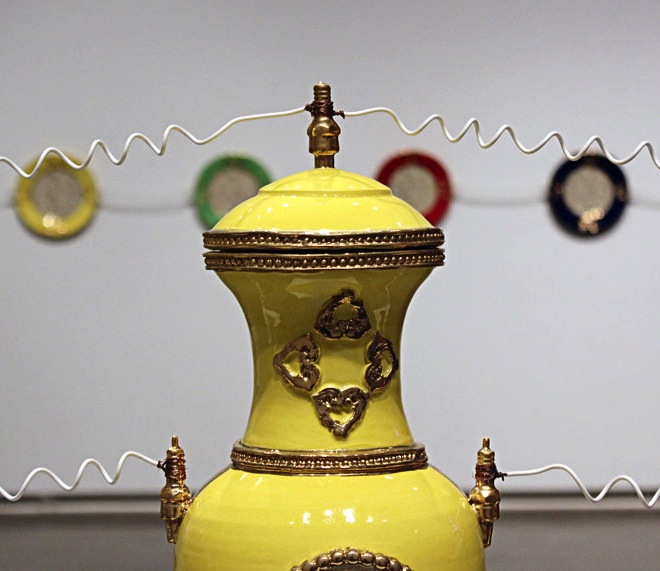The very earliest technologies can be seen as extensions of our own organs. A stick is a longer arm. A rock is a detachable fist that’s propelled through the air by our fixed hand. These tools are nothing without the animation of our bodies. But the relationship between technology, tools, and our bodies is ever-evolving. Since the first wind up clocks, we complicated and obscured the animating principle behind the technologies we create. With electricity, we might almost believe there is a source of motion intrinsic to our devices. Today, it seems we are being pulled further away from a physical connection to technology by the abstract processes of computing and the invisible wonders of micro processing. But digital technology may actually be bringing that connection back. Consider touch screen technology. In fact, it may not only be offering a reconnection to our bodies, but also new ways of connecting with art.
All these ideas about technology and our bodies were brought to CFile’s attention by Aaron Nelson, an artist from Alberta, Canada, whose show, Connectivity, attempts to address not only the role of ceramics in an electrified, digital world, but also the ability of contemporary technologies and networking to bring art audiences closer to craft processes and art itself. Connectivity was on view at the Esplanade Arts and Heritage Center in Medicine Hat, Alberta, Canada from October 26 through December 7, 2013.
In Connectivity, Nelson’s handmade traditional tea cups, platters, vases and porcelain chandeliers are connected, sometimes by way of their decorative gold luster, with electrical and electronic circuitry, telephones, iPods, generators, light bulbs and audio speakers. The gilded decoration works as a simple circuit board – the surfaces of the ceramics become energized with flowing electrons as they transmit electrical current and data. Visitors are invited to ‘turn on’ and interact with the pieces physically or through their electronic devices. In Haptic Stance, Nelson has replaced the nob of a vase with an iPod showing a video of him throwing the nob.
With a team of helpers, Nelson made chandeliers for the show that were connected to the internet. One could send a text message to make them change colors. During the exhibition they changed color on an average of about 300 times a day with texts from all over the world. Videos of the chandeliers were also streaming on a live feed and could be viewed online throughout the exhibition.
Aaron works with experimental, highly translucent soft paste porcelain that matures at an extremely low temperature. His interest in this new material, for which there are few historical precedents, grows out of a concern for the environment and reducing the carbon footprint of his practice. With his new porcelain body, he is able to marry the gesture, spontaneity, and aesthetics of handmade ceramics with a material generally associated with industrial ceramics or glass.
With the birth of digital modeling and the prevalence of digital communication, ceramic creatives are in a complex relationship with the old fashioned physical processes of ceramics. In many studios ceramics remains directly physical. Hands still move through a fluid material to create a pot on a wheel. Or a handle is still extruded by touching forefinger and thumb together and repeatedly pulling this ring of flesh down the slicked surface of a lump of clay. These processes champion the manual, the dexterous and the visceral. They are physical connections between life and mineral. Connectivity seems to be grappling with a way to bring these processes into concert with the electrified digital age. Watch the video below, and browse through the images to get a sense for yourself of how this worked in Connectivity.
Aaron Nelson graduated from Emily Carr University. Since then he has had studio practices in Chicago, Vancouver, Victoria, and Montana and is currently residing in Medicine Hat, Alberta. Aaron is the Artistic Director at Medalta in Medicine Hat Alberta, but is also an educator. He recently received a Canada Council grant for Connectivity.
CFile learned of this project through our submissions process. We welcome our readers to submit their own work for publication.
Above image: Foreground: Aaron Nelson, Ohm, 2013. Earthenware clay and glaze, 24 karat gold, copper wire, LEDs, dynamo. Courtesy of the artist. Photograph by Luke Fandrich.
A tour of Aaron Nelson’s exhibition, Connectivity, with the artist. Video by ShawTV.

Installation view of Aaron Nelson’s exhibition, Connectivity, at the Esplanade Arts and Heritage Centre, Medicine Hat, Alberta, Canada.


Aaron Nelson, Pixel, 2013. Steel, rare earth magnets, repurposed Hycroft china, digitally printed decal.

Aaron Nelson, Haptic Stance, 2013. iPod, video, aluminum, earthenware clay and glaze, 24 karat gold.




Aaron Nelson, Ohm, 2013. Earthenware clay and glaze, 24 karat gold, copper wire, LEDs, dynamo.




Aaron Nelson, Analog, 2013. Radio, copper wire, earthenware clay and glaze, 24 karat gold, speaker.

Nelson’s chandeliers were connected to the internet and the colors could be changed by texting a specific phone number that was free of charge and heavily used by visitors to the exhibition and those that viewed it online.




Aaron Nelson, Chain(ge), 2013. Porcelain, aluminum, digitally controlled LEDs.






Aaron Nelson, On the Knife’s Edge, 2013. Soft paste porcelain, aluminum, aircraft cable, digitally controlled LEDs. All images courtesy of the artist. Photography by Luke Fandrich.

Add your valued opinion to this post.